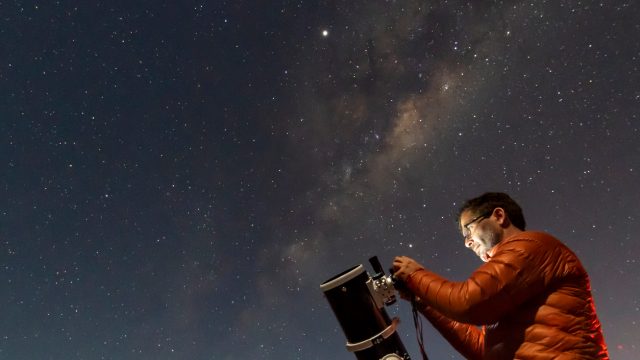2 “Stars of Bethlehem” Light Up the Sky This Week—How to See Them

The night sky can present some incredible sights at any time of year, and winter is no exception. Those who are willing to brave the chillier temperatures can witness what many consider the “best meteor shower of the year,” while celestial movements can create other incredibly rare events. And this year, holiday stargazers will get an extra special treat as two “Stars of Bethlehem” light up the night sky.
RELATED: “Overlooked” Last Meteor Shower of the Year Can Be Seen With the Naked Eye This Weekend.
Throughout history, astronomers and researchers have delved into different celestial events that might have created the brilliant beacon referenced in the Bible. Theories have ranged from a rare supernova blast to Halley’s comet passing by, Forbes reports. But two spectacles will be visible this year that could also be considered contenders—neither of which are actually stars.
The first is Jupiter, the largest planet in our solar system that’s a fixture in the nighttime sky throughout most of the year. But while it’s often visible, the gas giant increases in brightness at points in its orbit, becoming the most brilliant when it’s opposite from the sun as seen from Earth, per Forbes. This holiday season will see Jupiter just past its bright point that fell on Nov. 2 and 3, but it’s still rising as a very bright object that’s visible for most of the night.
Regarding historical sightings, Jupiter also stands out due to periods in its orbit where it appears to stand still in the night sky. “During the time of Christ’s birth, one of these stationary points occurred when Jupiter was directly overhead in Bethlehem for several nights, aligning with biblical accounts,” Minjae Kim, PhD, a research fellow at the University of Warwick in the U.K., told Forbes.
The other is Venus, our closest neighbor and the only celestial object brighter than Jupiter besides the sun and the moon. The planet has even earned the nickname “Morning Star,” rising in the pre-dawn hours before sunrise, according to Forbes.
While these planets burn brightly on their own, there’s another major event that creates an even bigger nighttime spectacle and is often considered a potential candidate as the “Star of Bethlehem.” A rare event known as the “Great Conjunction” occurs when Saturn and Jupiter cross within 0.1 degrees from each other in the sky at their farthest points from the sun, creating an amplified effect that makes them appear more brilliant, Astronomy.com reported.
RELATED: 8 Amazing Things You Can See in the Night Sky Without a Telescope.
Earth was treated to this miraculous view for the first time in nearly eight centuries on Dec. 21, 2020, making it possible to view both gas giants within the view of a single telescope lens. But those hoping to see it again will have to wait a while: The next occurrence of this rare astronomical event won’t occur until 2080.
If you’re looking to catch sight of either Jupiter or Venus while celebrating, experts say neither will be challenging to find. Those who are up early on Christmas Day might be able to catch a glimpse of Venus before daylight blurs out the planet, while Jupiter can be spotted anytime after twilight.
“By approximately 9 p.m., Jupiter will be high in the southern sky, offering a splendid view until it set in the west around 3:30 a.m.,” Kim told Forbes.
And that’s not the only event taking place. The annual Ursid meteor shower will also peak on the night of Dec. 22 and trail off through the middle of next week, Live Science reports. While it’s not typically as impressive as the Geminid meteor shower that precedes it by a matter of days, viewers can expect to see five to 10 “shooting stars” per hour at its most active.
RELATED: For more up-to-date information, sign up for our daily newsletter.